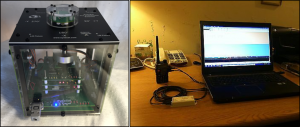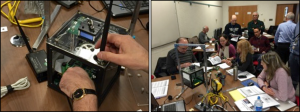Life cycle of a PNMSat mission, Hands-on experience using Classroom Satellite Kit
Goal/Purpose
The goal of this workshop is to provide an overview of PNMSat Engineering and a roadmap of 3-5 years to successfully start a PNMSat Program and potentially launch an academic satellite. The underlying intent of the workshop is to emphasize the integration of education, research, and development to sustain a PNMSat program at an academic institution.
Objectives
The specific objectives of the planning meeting are as follows:
- Facilitate faculty and students to understand the functions of various subsystems of a PNMSat through a hands-on demonstration using a classroom satellite kit from EyasSat.
- Provide an overview of a typical PNMSat Mission Life Cycle, Budget, Timeline, etc.
- Engage the participants, students, faculty and administration, in initiating a PNMSat program.
The workshop will provide rudimentary hands-on training using a classroom satellite kit, which is a functional representation of a PNMSat and demonstrate packet radio communication (Figure 1).
- Electrical Power System (EPS)
- Command & Data Handling (CDH) System
- Tracking, Telemetry, & Command (TT&C) System
- Attitude Determination & Control System (ADCS)
- Structural & Thermal (S&T) System
- Ground Station Communication Emulation

Figure 1 – (a) Classroom Satellite Kit, (b) Packet Radio Communication
Workshop Agenda
To facilitate the above goal and achieve the stated objectives, the workshop is planned in 2 sessions:
Session I
The first session will present an overview of a custom developed Mission Life Cycle for PNMSat, including CubeSat class of satellites and an introduction to the various subsystems of a PNMSat. As part of this session, ham radio communication, including packet radio, exercise may be planned.
- Provide an overview of a typical PNMSat Mission Life Cycle (~45 minutes)
- Pre-Stage I –- Mission Concept and Preliminary Mission Design
- Stage I –- Systems Engineering Training for Mission Execution
- Stage II –- Mission Design, Design Validation, and Virtual Assembly
- Stage III –- Development, Unit/Integration Level Testing
- Stage IV –- Assembly, System Level and Environmental Testing
- Stage V -– Post Launch Operation
- Review of Orbital Mechanics and Overview of Satellite Subsystems (~1 hour)
- Electrical power system
- Command and data handling system
- Telemetry, tracking, and command
- Attitude determination & control system
- Structural & Thermal System
- Propulsion system
- Ground operations
- Overview of PNMSat payloads developed as part of a short course offering (~15 minutes)
Session II
The second session will focus on providing hands-on experience in assembly/integration and conceptual operation of a PNMSat using the Classroom Satellite Kit (Figure 2). The participants may be divided into groups to experience Classroom Satellite Kit in an ESD laboratory:
- Gain an understanding of the various constituents of a subsystem (visual inspection)
- Experience the integration/assembly and functioning of the Classroom Satellite Kit
- Experience the concept of a ground station to satellite communication
- Telemetry and telecommand operation

Figure 2 – A typical hands-on activity involving the classroom satellite kit
Here is a link for a printable pdf of the workshop information.

Recent Comments